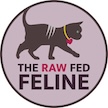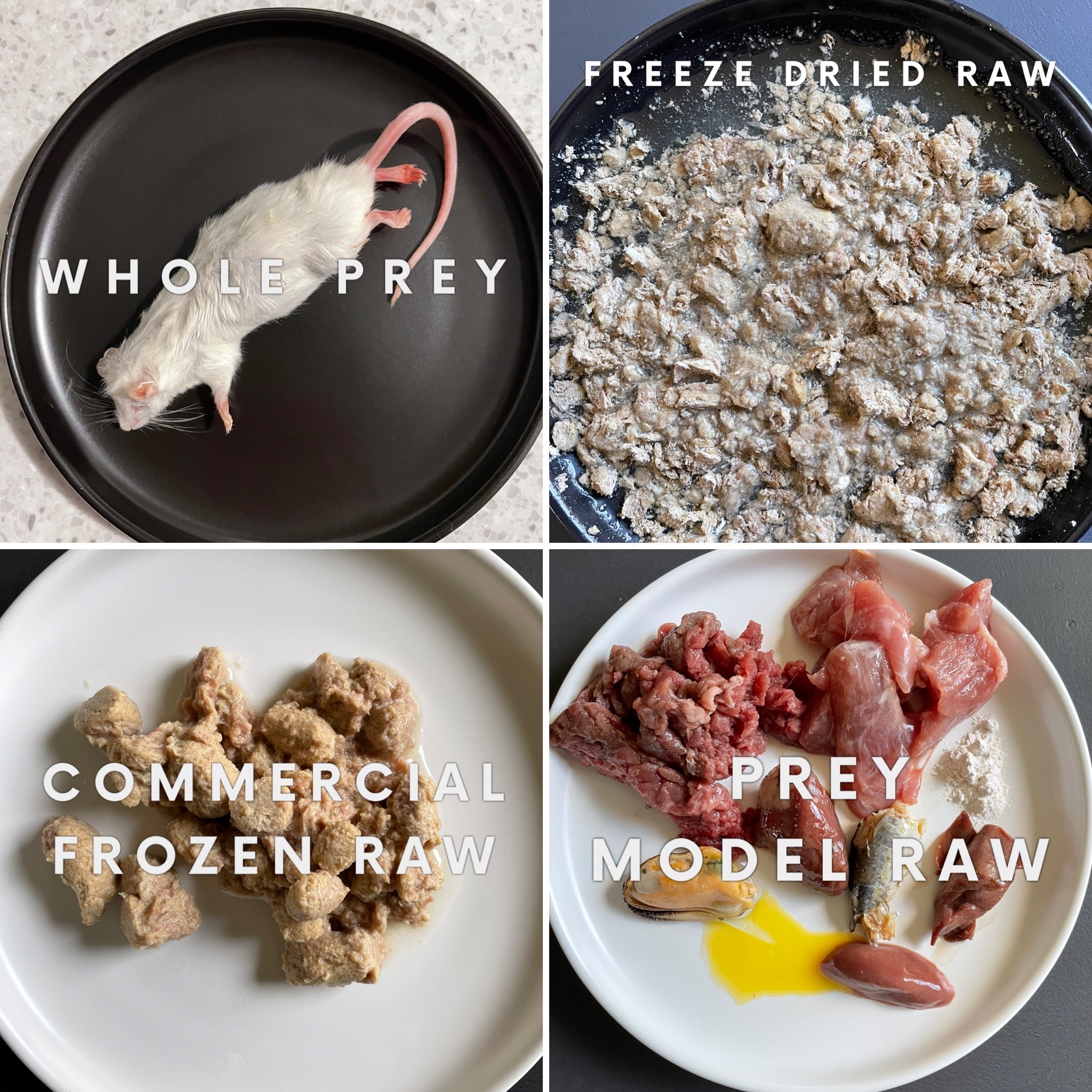There are so many options when it comes to feeding your cat raw. I love that there is more than one way, so you can find the way(s) that work for you, your cat, and your situation. How you feed raw may change over time—you are not committed to feeding one way forever. Feeding raw can be as simple or involved as you want it to be. It all depends on your interest level, time, and resources available. If you’re not sure about why feeding raw is a great idea for your cat, check out this post.
Commercial freeze dried raw, commercial frozen raw, pre-mixed completers, prey model raw, NRC based raw, and whole prey are all options for raw feeding your feline. I started raw feeding with freeze dried foods and have fed Hazel lots of different ways. There are pros and cons with each one, so let’s take a closer look.
Commercial raw food options
Freeze dried foods have undergone a process of extreme freezing and then have any moisture removed. This process results in a very dry, shelf stable food that retains its nutritional value and is still considered raw. Some freeze dried foods have also been treated with High Pressure Processing (HPP), which decreases the amount of bacteria. To feed, you crumble up the food and add water, then mix together. That’s it—super easy!
One of the most important things to remember when feeding freeze dried foods is that you MUST rehydrate them—even if the bag says you can feed it dry. Freeze dried foods have even less moisture than dry kibble and if fed dry will cause dehydration and possible constipation. Freeze dried foods are very convenient. They are a nice option when you don’t have freezer space or for traveling (pros) because they are shelf stable. However, they tend to be a more expensive way to feed raw (cons).
Frozen commercial raw foods are another pre-made option. You can find these foods in the freezer section of most pet stores. To feed, you just thaw in the fridge, then scoop and serve. They are an easy and extremely convenient way to feed a raw diet (pros). They can also be expensive as you pay for that convenience. You have to determine if the ingredients used are appropriate for your cat and have some freezer space available (cons).
Ways to make raw food
Now we are going to look at different ways to make your cat’s raw food yourself. Pre-mixed completers are easy to use because the calculations of the individual nutrients have been done for you. There are several options on the market. The differences between them are related to the calcium source, and whether you need to add omega-3s or liver. In general though, you just mix together plain boneless meat, water, and the completer powder, which is as simple as it sounds.
Using completers is a fantastic way to dip your toes into making your cat’s food. It tends to be less expensive than feeding commercial foods since you mix up the food yourself. It is an attractive way to feed raw when factoring in time, cost, and quality (pros). However, there is not as much organ variety when using completers and you can’t individualize it for your cat (cons).
DIY raw
Prey model raw (PMR) takes making your cat’s food to another level. This way of feeding is based on the whole prey animals that your cat would naturally eat. You are putting together the components of the food yourself: the meat, bone, organs, and necessary additional nutrients, theoretically based on the average ratios of whole prey. For cats, the typical ratio used is 84-6-10, which means 84% meat, 6% bone, and 10% organs are fed. You can make feeding a PMR diet very cost effective. Plus, you control all of the ingredients and you can individualize the diet for your cat (pros). It takes more time to plan, prep, thaw, and prepare when feeding this way. It also requires a certain degree of nutritional knowledge to do so correctly (cons).
NRC based raw feeding is similar to PMR, but with a slightly different focus. NRC stands for National Research Council, which provides minimum and recommended guidelines for individual nutrients in the diet. Raw feeders can use NRC guidelines to determine what nutrients to include in their cat’s food. As with PMR, you can make feeding a NRC based raw diet very cost effective. You control all of the ingredients and you can make it highly individualized for your cat (pros). It takes more time to plan, prep, thaw, and prepare. It also requires a high degree of nutritional knowledge to do so correctly (cons). Many professional nutritionists use NRC guidelines to prepare meal and feeding plans for their clients.
Whole prey feeding
Now, let’s consider whole prey feeding. It is what other forms of raw feeding are ultimately trying to recreate, either by nutrients or ratios. Cats are biologically designed to eat whole prey. Whole prey raw feeding is also the easiest way to feed in terms of the mechanics. You just thaw in the fridge and give your cat the animal. Your cat does all the work and reaps the benefits from doing so (pros).
You typically buy whole prey from online suppliers that are shipped frozen, which is expensive. While individual mice and chicks are not that expensive, other prey animal options cost more. You would need to feed 5-6 mice a day to an average adult cat, which adds up quickly.
The other issue is that for most people, the idea of feeding a whole animal can be too upsetting. We know intellectually that all pet foods are made of other animals, but seeing the whole animal hits differently. Most people who feed whole prey do so as a part of their cat’s overall raw diet, but not exclusively, due to cost (cons).
So, as you can see, there are several options for how to have a raw fed feline! What ways have you fed your cat or what ways are you interested in learning more about?



2 responses to “All the ways to feed your cat raw”
I use freeze-dried meats as dry treats (for treat puzzles for example) and also crumbled up as a topper to encourage eating of newly introduced things.
It has also proven really helpful to feed freeze-dried organ meats if the cat refuses to eat fresh ones at first. If not accepted as a treat, you can eaven grind it up and feed the powder stirred in yoghurt/kefir/egg/bone broth (whatever makes your cat happy).
Great suggestions! Single ingredient freeze dried meat treats are excellent options for treats and toppers.
Using freeze dried organs in place of fresh is also another good idea. It’s important to calculate the correct amount as it is not a 1:1 swap. This is a helpful calculator to figure out how much freeze dried organ to use: http://www.rawcalc.org/freeze-dried-fresh-equivalents.html